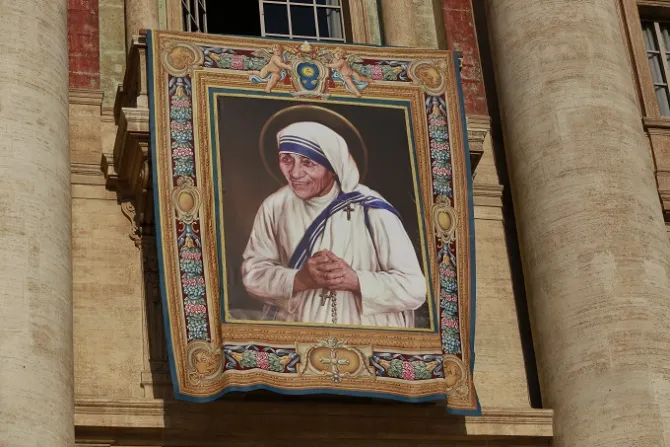Vatican City, Sep 4, 2016 / 01:40 am
Pope Francis on Sunday officially declared Mother Teresa of Calcutta a saint of the Catholic Church in front of thousands of pilgrims in St. Peter's Square – a move the entire world has been waiting for.
"For the honor of the Blessed Trinity, the exaltation of the Catholic faith and the increase of the Christian life, by the authority of our Lord Jesus Christ, and of the Holy Apostles Peter and Paul, and our own, after due deliberation and frequent prayer for divine assistance, and having sought the counsel of many of our brother Bishops, we declare and define Blessed Teresa of Calcutta to be a Saint," Pope Francis exclaimed Sept. 4 as the crowd roared with applause.
"We enroll her among the Saints, decreeing that she is to be venerated as such by the whole Church. In the name of the Father, and of the Son, and of the Holy Spirit."
Throngs of pilgrims flooded the Vatican on Sept. 4 to celebrate the highly anticipated canonization of Mother Teresa, an event that Catholics and non-Catholics alike have looked forward to since the nun's death in 1997.
Her canonization is significant not only because it took place during the Jubilee of Mercy, but also because it fell during a special Sept. 2-4 Jubilee celebration for workers and volunteers of mercy, of whom Mother Teresa is widely considered one of the greatest of our time.
Mother Teresa is officially a saint! Here's a portion of the Pope's declaration! #MotherTeresa https://t.co/Q80ihsT3nx
- Catholic News Agency (@cnalive) September 4, 2016
Mother Teresa was born Agnes Gonxha Bojaxhiu Aug. 26, 1910, in Skopje, Macedonia. The youngest of three children, she attended a youth group run by a Jesuit priest called Sodality, which eventually opened her to the call of service as a missionary nun.
She joined the Sisters of Loretto at age 17 and was sent to Calcutta, where she taught at a high school. After contracting tuberculosis, she was sent to rest in Darjeeling, and it was on the way that she felt what she called "an order" from God to leave the convent and live among the poor.
The Vatican granted her permission to leave the Sisters of Loretto and to live her new call under the guidance of the Archbishop of Calcutta.
After she left her convent, Mother Teresa began working in the slums, teaching poor children, and treating the sick in their homes. A year later, some of her former students joined her, and together they took in men, women and children who were dying in the gutters along the streets.
In 1950, the Missionaries of Charity were born as a congregation of the Diocese of Calcutta. In 1952, the government granted them a house from which to continue their mission of serving Calcutta's poor and forgotten.
The congregation quickly grew from a single house for the dying and unwanted to nearly 500 houses around the world.
Mother Teresa set up homes for prostitutes, battered women, orphanages for poor children and houses for those suffering from AIDS.
She was a fierce defender of the unborn, and is known to have said, "If you hear of some woman who does not want to keep her child and wants to have an abortion, try to persuade her to bring him to me. I will love that child, seeing in him the sign of God's love."
She died Sept. 5, 1997, and was beatified just six years later by St. John Paul II Oct. 19, 2003.
(Story continues below)
Read more on the canonization Mass and Pope Francis' homily:
<blockquote class="twitter-tweet" data-lang="en"><p lang="en" dir="ltr">In his homily for Mother Teresa's canonization, Pope Francis reflects on our 'vocation to charity' <a href="https://t.co/FfTTLoOb5H">https://t.co/FfTTLoOb5H</a> <a href="https://twitter.com/hashtag/BeMercy?src=hash">#BeMercy</a></p>— Catholic News Agency (@cnalive) <a href="https://twitter.com/cnalive/status/772385546626736128">September 4, 2016</a></blockquote>
<script async src="//platform.twitter.com/widgets.js" charset="utf-8"></script>



